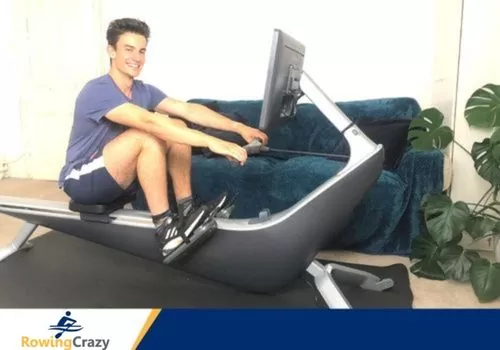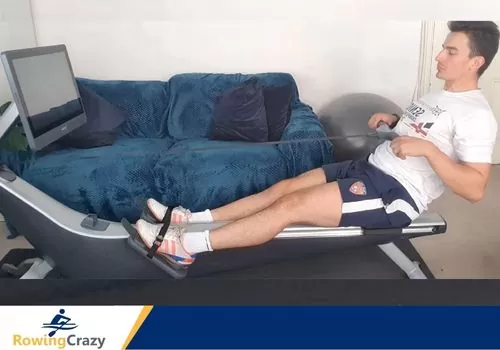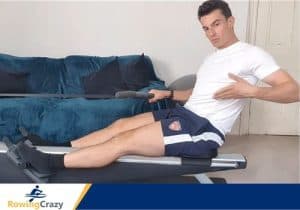
How do I get a faster 2K time? It’s a question that everyone who cares about their rowing seems to ask themselves at one point or another! The good news is that I’ve got the answer for you!
The points I’m going to explain below are points that should work for everyone – whether you’re Oli Zeidler or a complete novice. Read on and you’ll find your erg times dropping and other metrics on your performance monitor improving!
My Personal Tips to Get Faster at Rowing
#1- Plan Your Row
The first step to rowing faster is to ensure that you’ve planned out your row before you get anywhere near the rowing machine. Be it an erg test or just a simple training piece, have a plan for how you’re going to tackle the workout.
Going into a workout with some targets in mind will give you a huge mental advantage over the piece – especially for longer rows. Being able to break a long piece into a few separate sections and tick off the sections as you go through it will help you start crushing your workouts.
If you’ve never done the piece before, seek some suggestions for how to break it up from a friend or team mate who has done it before. Alternatively, have a look online. There’s loads of race plans on the internet!
I’d also suggest giving yourself some technique focuses during each part of the breakdown. Maybe you want to think about the catch for the middle minute and then move on to thinking about keeping your shoulders low and loose – or maybe the push with the hips. Having technical focuses is going to help you maintain your efficiency and hit that peak performance.
Technique Focuses

One way to row faster is to improve the mechanics of your rowing stroke so that you reduce the resistance that your body creates as you row.
A few technical aspects you might want to focus on during a piece:
- Shoulders – keep them low and loose, make sure you’re not pulling through them.
- Catch – make sure you’re fully prepared with the chest up and your arms out long as you arrive to take the next stroke.
- Heels – focus on shifting the press from the toes to the heels as you drive your knees down. This will help you to have an efficient hip swing.
- Feet first – make sure that the first movement out of the catch is a push with the legs, not your back opening.
- Hamstrings – as you swing your hips forward on the recovery, are you feeling that little tug on your hamstrings? If you’re not, you might not be rocking forward at the correct time in the stroke, or you’re not rocking enough.
- Reach – don’t go reaching for too much at the catch. You’re far better rowing a little shorter and enjoying the more efficient stroke and stroke rate.
#2- Improve Your Technique!

Max Secunda Perfecting His Rowing Technique
Absolutely everyone can improve their erg technique!
This is a sentence that I will argue about until the sky falls down! There is not one person in the world, nor will there ever be, who has ‘perfect’ erg technique! Therefore, there’s always space to improve your technique, no matter how good you think you are!
The best way to start improving your rowing technique is to film yourself from the side at low stroke rates and then again at a higher stroke rate.
Once you have some footage of yourself, watch it back in slow motion. Chances are you’ll be doing something wrong and you had no idea you were doing it!
For example, I filmed myself a few weeks ago and found that I was bending my arms very slightly as I took the catch – I didn’t think I was doing this at all! I had absolutely no idea I was doing it!
A bit of filming helped me realize that I was doing this and then helped me focus on it whilst I was doing low-intensity ergs. It allowed me to start building some good habits to fix the issue.
Steady-state rowing is often quite dull, but a very good way to make it more interesting is to focus on what you’re doing and try to fix it as you do so.
#3- Train Hard!

My Typical Training Session
It sounds obvious, but you need to be following a good training plan and working hard in your hard sessions to get faster!
You will not be able to do an amazing erg test if you aren’t training to perform an amazing erg piece.
When you’re training hard, make sure you’re doing it with good technique! As I mentioned above, long, slow ergs are a good place to drill in habits, but you need to make sure you’re taking these forward into the hard efforts.
Rowing at a High Rate

Max Secunda Rowing on a Hydrow Rower
High rate rowing is absolutely crucial for people looking to row faster. High rate sessions can be some of the hardest forms of rowing workout ( read more on indoor rowing workouts for weight loss ) , but they’re worth sitting through if you want to drop your rowing split time!
As a sub-heading within the category of training hard – make sure that when you’re training hard, you’re training at a high stroke rate (where appropriate). For a 2k test (read our 2k Rowing Test Training Plan ), I’d recommend that you don’t drop below 32 strokes per minute. My 2k PB was set at 36 strokes per minute, although the last 500m was pushing 40 spm!
The best way to start rating higher is to practice rating high in your training sessions. This might involve lowering the drag setting on your rowing machine (I often use 120 on a Concept 2) and just trying your best to sit at a nice high rate.
Here’s my video to show you my secret to rowing at a high rate:
The first few workouts where you practice this technique might be a bit tough, but your body will soon adapt and you’ll become so much more efficient from it. I recommend short interval training sessions to get used to it then lengthen it onto longer pieces. You’re going to see your split time drop rapidly, and your indoor rowing times drop too!
#4- Train Easy!

Max Secunda Working Out at Home on the Hydrow Rower
Finally, you have to remember that to get faster, you shouldn’t be training hard every single session. Sometimes it’s important to train easier! As a general rule, to allow for adequate recovery, 80% of your sessions should be ‘easy’.
By ‘easy’ I mean sitting for a long period of time at a low heart rate (50-75% of your max) and just racking up the distance on the erg! It sounds bizarre at first – but this is going to have a very big impact on your performance. Make sure you hold the stroke rate nice and low for these ergs – I’d recommend 18-20.
Common Rowing Mistakes & How to Fix Them
If you’re asking “Why am I so slow at rowing?” perhaps it’s time to also start asking what rowing mistakes you’re doing and how to fix them.
Generally speaking, there are a few problems that everyone will have at least one of. Below I have listed out these problems and some ways to fix them.
Pulling Early with Arms

Max Secunda Demonstrating the Catch Position
This is a very common problem (as I mentioned, one I suffered from). It comes in two forms, either you bend your arms at the catch – which forfeits the ‘hanging’ feeling that you want to get to have the most efficient stroke possible.
The way to fix this is to think about keeping your arms super loose and relaxed as you approach the catch, then make sure you’re leaving your arms long as you push your legs away. Having a horizontal mirror next to yourself can help you to develop this habit.
I’d also suggest rowing on a much lower drag factor than usual. The low drag setting will force you to use your legs first, if you want to get a good split that is! Working on this is going to help you maintain a much smoother stroke when you’re in your high-rate pieces.
Incorrect Body Position

Max Secunda Showing Correct Body Position
The common fault here is not getting your body set in the correct sequence. All too often, I’ll see rowers thrusting their hands away and then sliding up the monorail early, only to flop their body forward when they arrive at the front.
This is a very inefficient way of rowing and will be costing you rate and therefore split time when you’re going into your pieces.
In steady ergs, drill in a sequencing habit. It might feel a little robotic at first, but in time you’ll relax into it. You’ll be able to create good rowing mechanics and a much better power output from being in the correct positions at the correct times.
Watch Olympic Rower Rachael Taylor’s Guide to Correct Rowing Machine Form:
Failure to Rock from the Hips

Max Secunda Emphasizing His Torso And Hip Position
This can often be a mobility issue (see my article on rowing mobility), but the common issue here is failing to rock forward from the hips. Athletes can rock from their back instead. This is not only putting the back and upper body at risk of injury, but it’s also an inefficient way to row!
When you fail to rock the hips forward, you sacrifice the second half of the stroke! You loose so much on the split time by not using your hips to swing through in the second half of the drive.
Fixing this issue is key to rowing faster and pushing up your rowing!
Again this is something to fix on those long, slow, endurance ergs. Think about rocking forward from the hips – being mindful of what your body is doing is key to this.
Make sure you’re keeping your chin up as you’re rowing. If your eyes fall down and your head position drops, chances are you’re not rocking forward properly.
The Final Takeaway on Rowing Faster
Doing these long steady rowing workouts will give you a good opportunity to work on your rowing form and focus on some technical aspects that you need to fine-tune.
Make sure that for every workout session you do, you go in with an idea of what you want to improve. It’ll help you to get better at your rowing and row faster in the long run!
Written by Max Secunda – RowingCrazy.com
Experienced Heavy Weight Rower, Rowing Instructor & Coach, Novice Men’s Rowing Captain, British Concept 2 Record Holder & Rowing YouTube Influencer
Max is a rower at Vesta Rowing Club based in London, UK. He started rowing at the University of Sheffield, where he also was the Captain of the Novice Men’s Rowing Team, Max has a well know YouTube channel where he vlogs about his rowing training and experiences.






